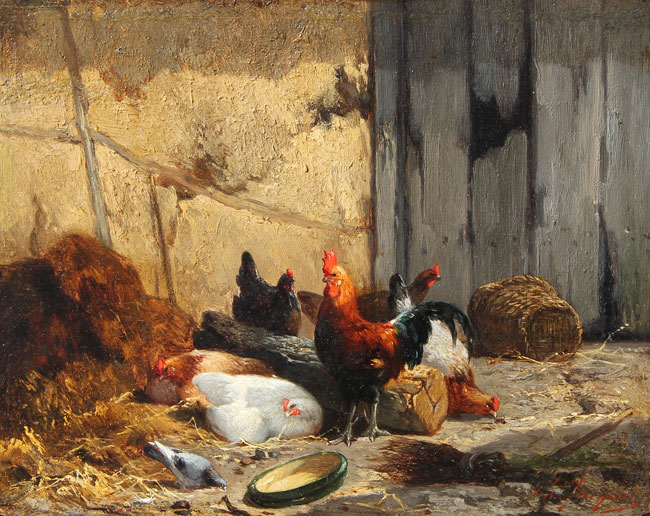CHARLES EMILE JACQUE PAINTINGS FOR SALE & BIOGRAPHY
CHARLES EMILE JACQUE
French, 1813–1894
BIOGRAPHY
Charles Emile Jacque was born in 1813 in Paris. He was a painter, engraver and draughtsman, with his subjects being limited to mostly interiors with figures, landscapes with figures, animals and farmyard scenes. Jacque started out apprenticing with an engraver of maps at 17. But, from the start, he was interested in art and produced Woman’s Head, his first etching in the style of Rembrandt, at a young age. However, he became disenchanted with engraving because of the environment where he worked, and enrolled in the army. He was there for seven years and participated in the siege of Anvers in Belgium, which inspired his drawing entitled Anvers, which he later engraved. When he finished his military service he went to England, where he worked for two years on woodcarvings for the design of works by Shakespeare and a History of Greece. After returning to his home of France, he travelled to Burgundy, before going back to Paris and settling there. He produced some of his best work in Barbizon, in the forest of Fontainebleau. Similar to Rousseau, Jacque was a Barbizon School painter, and was said to have been its last thriving artist.
His career began in 1845 through his exhibitions of his etchings at the Salon. In years after he continued to show his etchings. He exhibited his first painting at the Salon in 1848, thus he initially gained his status as an artist through his etchings and then with his paintings. For his engravings he achieved a third class medal in 1851, as well as two rappels in 1861 and 1863, a second class medal in 1867 and a major prize in 1889. In addition, he was awarded many honors for his work as a painter. He obtained a third class medal in 1861, a second class medal in 1864 and a gold medal at the Exposition Universelle of 1889. Throughout the years, Charles Emile Jacque contributed regularly at the Paris Salons, excluding the years of 1870 to 1888. But when he returned to exhibiting in 1888, he debuted The Large Herd one of his most expert paintings. After his death in 1894, his works were included in a show dedicated to Paysages de Bourgogne, de Corot á Laronze in 2001 in the Musée de Beaux–Arts in Dijon.He was awarded the Légion d’Honneur in 1867.
Charles Emile Jacque’s expertise can be seen as an embodiment of the Barbizon School. It includes all of its strengths and a scarce amount of its flaws. Although there are aspects of his works that fall short and are somewhat unoriginal, there are noteworthy features that far outweigh those shortcomings. For example, his sheep are relatively straight–forward although still skillful but his skies, the feeling of liveliness and the latitude of arrangement are remarkable. Jacque got his inspiration from pastoral scenes and not the synthetic imitations of them that were very present in the 18th century but confusing, raw depictions of more realistic scenes. In particular, he shone when it came to portraying birds because he was able, possibly more than any other artist, to express the nervous motions of them. His unique, detailed, thorough style is demonstrated clearly through his work Domestic Fowl, 1869. Despite his success as a painter his favorite medium was etching, which he was also very skillful at and which earned him the majority of his great successes. The timeline of his etching can be divided into two periods, from the beginning on his career to 1860 and then towards the end of his career. His styles differed between the two times, his earlier style consisting of elegant features, which could be labeled as perhaps too purified. His later style developed into something more delineated, active and realist.
His work has been shown in museums and galleries in Amsterdam, Angers, Béziers, Chambéry, Glasgow, La Rochelle, Montreal, Nantes, Paris (Musée d'Orsay), Rheims, Sheffield, St–Étienne, and The Hague.
Museum Collections:
Albertina Museum, Vienna
Art Institute of Chicago, Chicago, IL
Ashmolean Museum, Oxford
Brooklyn Museum, Brooklyn, NY
Courtauld Institute of Art, London
Hermitage Museum, St. Petersburg
Huntington Library, San Marino, CA
Metropolitan Museum of Art, New York, NY
Minneapolis Institute of Arts, Minneapolis, MN
Musée du Louvre, Paris
Musée d’Orsay, Paris
Museum of Fine Arts, Boston, MA
National Gallery of Art, Washington, D.C.
Philadelphia Museum of Art, Philadelphia, PA
The Walters Art Museum, Baltimore, MD
Mark Murray Fine Paintings is a New York gallery specializing in buying and selling 19th century and early 20th century artwork.
Please contact us if you are interested in selling your Charles Emile Jacque paintings or other artwork from the 19th century and early 20th century.
CHARLES EMILE JACQUE
Paintings for sale
Currently there are no available Charles Emile Jacque paintings for sale at the Mark Murray Gallery.
Please contact us if you are interested in selling your Charles Emile Jacque paintings or other artwork from the 19th century and early 20th century.
Charles Emile Jacque Paintings Previously Sold
CHARLES EMILE JACQUE
Le Grand Troupeau
Oil on canvas
25¼ x 39½ inches (64.2 x 97.5 cm)
SOLD
CHARLES EMILE JACQUE
Barn Interior with Fowl
Oil on panel
6½ x 8¼inches (16.5 x 21 cm)
SOLD



